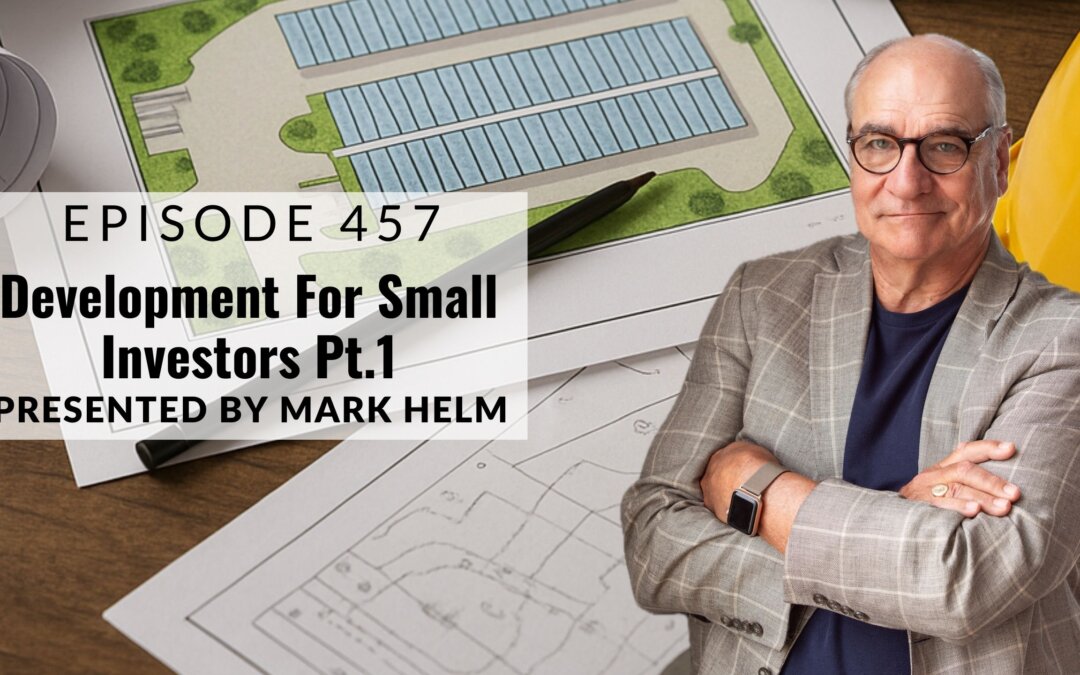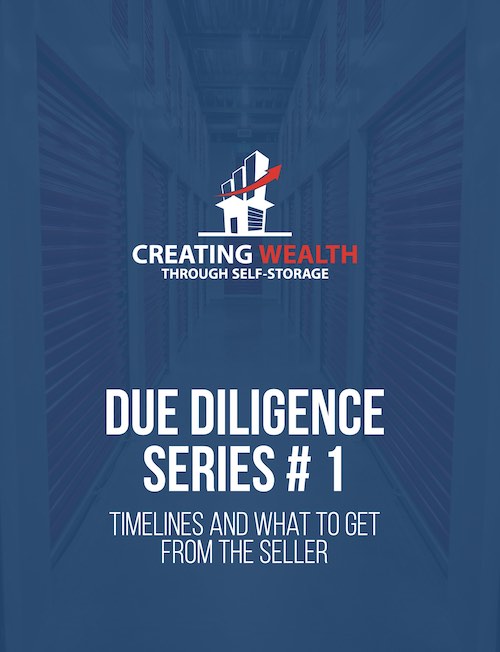Given the continued high cost of existing self-storage facilities for sale and the challenges of getting into the business, let’s discuss the development steps for smaller investors.
Or at least my take on the development process for the smaller player in the space. This has evolved over the years and was further refined and improved on by my construction partner, Smitty Smith, of Resolve Self Storage Construction.
I have divided the process up into five sections, or spaces to move through.
Over the next three episodes, we will explore each one in more detail. However, this is not comprehensive writing, and it does not include everything you need to know.
In Part 3 of this series, we will also touch on a few of the big mistakes we see people making in the self-storage development process.
Our Five Stages Of Self Storage Development
- Due Diligence/Planning & Development
- Development/Project Approval
- Construction
- Construction Administration & Completion
- Setting Up Operations
These are the phases or spaces we go through as we move from site identification to opening the facility.
Today, we will touch on the first two.
Due Diligence/Planning & Development
We see a lot of money wasted here from smaller investors who are not sure how or exactly what to do to get started on a self-storage project.
In our world, self-storage is different from almost any other asset class.
If I were building a hotel or shopping center, I would start with an architect to lay out our preliminary design and plans.
We absolutely do not do this with self-storage. We discovered that architects and self-storage fabricators are not on the same page and wavelength.
We always start with fabricators. Those are my first or second call when I think we have found a site.
Fabricators add a ton of value, and my experience is that a fabricated system is more appealing to buyers, especially institutional buyers, when it is time to exit the property.
Not to mention, it is a less expensive way to go.
Let’s look at the phases within this first space of self-storage development for smaller self-storage owners/operators.
- Analyze land
- Preliminary layout
- Proforma
- LOI/Contract
- Feasibility Report
- Understand codes/approval process
Analyze Land
We always start with the land. How does it lay? Is it wooded or not? What is the shape? Wetlands? Etc.
In our development process, the engineer is a key player, and this phase of development starts there. Often, even before we write an LOI on the site, we have identified a local civil engineer who will work with us utilizing the process we are describing here in these episodes.
They tell us about the site, most likely what any issues are, how we may mitigate them, and what the approval process will be like.
If at all possible, we never want to take land through rezoning. I hate that. I am sure there are great sites that would be wonderful for self-storage if we rezone them, but I usually don’t have the time, patience, or money to do that.
Our construction company has worked with others who have done that and have done it successfully. Just know you are usually adding 9 months to a year to the development process, and depending on where there is an additional cost of $60,000 to $200,000.
At least, that has been our experience.
Preliminary Layout
After talking with an engineer, we send the site plan or a survey to a fabricator and obtain a preliminary layout from them.
Upon receipt, we go over it with the fabricator, tweak it as we see needed at the time, and then send it to the engineer for their reaction and adjustment.
They will look at it from a regulatory point of view. Are fire lanes, right?
Is truck turn radius enough? Will this layout most likely get regulatory approval? If not, what needs to change?
Notice that no architect or engineer is creating the preliminary layout. They just react to it. This keeps costs down for this phase, and this is usually at-risk money. In other words, if we walk, we do not get reimbursed for this phase of the process.
Proforma
We always do a preliminary proforma using assumptions from the middle of the road. Lease up not too fast, but not exceedingly slow either. We will do a stress test later.
Construction numbers are usually per square-foot numbers at this stage as well.
Once we get the preliminary layout, we insert the unit mix where previously we had PSF income numbers, and we use a subscription service to estimate unit pricing for the location.
We know our benchmark return numbers, and if the initial proforma does not hit them or exceed them, we don’t spend much time on the site.
However, the Proforma is an evolving document. As we go further into the development process, it changes based on real numbers, replacing the initial assumptions. There is a tendency, even for me, to adjust some numbers to keep the benchmarks in place.
Believe me, don’t do this. I’ve learned the hard way.
LOI/Contract
Most people will say, “You make your money when you buy the property.”
I suggest you make your money in the LOI phase of the process. Here is where we think out what we can offer, how to structure the deal, etc.
Basically, our goal is to control the land at a known number for the “right” amount of time.
What is the right amount of time?
It depends on our preliminary conversations with the civil engineer.
Hopefully, for as long as needed to get our approvals.
If not for that long, then we negotiate the right to buy the time in increments as we move through the development process if the project can absorb those costs.
I have written about how we do this in many previous episodes.
Feasibility Report
After the contract is executed, the next document to execute is an engagement letter for a feasibility report from an independent, third-party feasibility expert for self-storage.
I have written about this often as well. On my website, CreatingWealthThroughSelfStorage.com/resources is a list of the people I have used.
This is usually a month or more lead time, so we do it immediately.
Understand Codes/Approval Process
This sounds like a given, but I am amazed how many small investors get far down the development road and spend money, only to have to make major adjustments because they did not read or understand the codes for that site development.
Believe me, it is a lot easier to make an adjustment on a piece of paper, like a preliminary layout, than to do it in the field.
This is where the engineer is important again. But do not just rely on the Civil. Download the land development codes and regulations and read them.
Ask questions. Ask the civil. Ask the county. Make sure you really try to get your head around them.
Ultimately, you are the one responsible for the project’s success and/or failure in this development process, which I am outlining. No one else.
Understand the codes.
Development/Project Approval
This is where many small developers shipwreck on the rocks of the regulatory agencies.
Your civil engineer is critical in our process. In 98 out of 100 cases, we have the civil lead in charge of obtaining the approvals, not the architect.
You will be only as successful as your team, so put a good team together.
It starts with a good civil engineer, a good feasibility report (not the least expensive), perhaps a good General Contractor who understands this process, or a consultant or Owners Representative who understands this way of storage development.
Here are the spaces to move through in this phase of the development process.
- Survey
- Site Plan
- Development/Project Approval
Survey
We usually have to get a new survey and a new topographical survey with site elevations at this stage. Your civil will tell you exactly what you need.
In most cases, we also get a Geo-tech report that tells us the compaction of the soil (I just included this report in the “survey” phase of the report).
Sometimes, we need an environmental report as well.
If you do not get an environmental report from the Seller, and if you cannot update it, I recommend always getting one.
I know there are some people who will argue with me that they don’t want to know if there is a problem. I do, however, so I can make the determination if I want to go on title to the land and assume the potential liability. If there is an issue, I want to know before I close.
If a Seller won’t let me do an environmental, I walk from the deal.
Site Plan
Here is where we start engaging with an architect.
In a perfect world, you have a relationship with an architect who understands self-storage and will work on an hourly basis.
That is what we have.
At the very least, we need to get pricing for them to do different “reactionary work” at different stages of the development process.
In this phase of the development process, I just want enough work to be able to have my civil engineer obtain development or project approval.
How much that depends on where and what county, but usually, it is a site layout, three-dimensional renderings (keep as generic as possible), and sometimes water drainage (again civil engineer) plans. Hopefully, there are no full-blown site work plans at this stage, although sometimes we have had to fund that here for development approval.
Hopefully, the architect can take the layout provided by the fabricator and run with it.
Often, we can get that layout in CAD format from the fabricator, making it much easier for the architect and civil engineer.
Pro Tip: See if you can negotiate a partial amount of the deposit in this phase of the project with your fabricator to have them provide the engineered plans for the building in CAD format so you can give them to architect and engineer. Have this non-refundable amount be applied to the deposit required when you are ready to go into the fabrication queue. For us, that is when we get development approval.
Development/Project Approval
Our goal is to spend only the minimum needed to get the project to the point where we can get approval to move forward.
This is usually a project or development approval. It is not the final building plan approval or site disturbance approval but the approval to move forward with the project.
Once this is obtained, we usually put the deposit, or the remaining portion of the deposit, down on the storage system, as well as cut the civil to finish the site work plans so we can get bids.
Also, we are constantly updating the proforma with new numbers as they come in.
Conclusion
Next week, in part 2, we will explore the two construction phases of our particular construction process for small investors.
Keep in mind we also use this for expansions and conversions, although sometimes in a modified way. In general, this is how we save money, especially in these first two phases of a project.
We have seen way too much money being spent by first-time and/or smaller investors who are just unsure how to get started.
If you really want to develop and are unsure just where to start, perhaps this will help. Also, reach out and get someone like us, a consultant, an owner’s representative, or someone to help before you just contact an architect to get started.
It could mean the difference between being able to do a project in 7% plus interest rate environments and high material and labor costs. We must watch every cent in order to make projects work today.
Thanks, and I look forward to being with you next week as we explore the construction phases of self-storage development for small investors.



